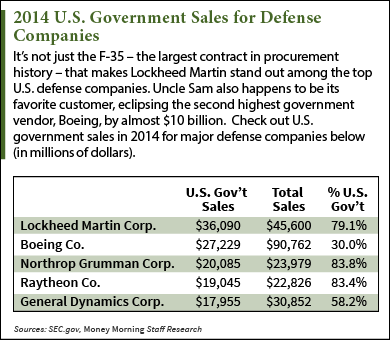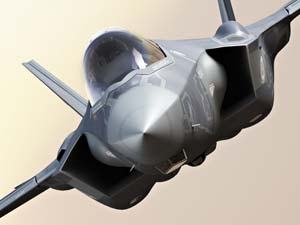All year the Lockheed Martin stock price (NYSE: LMT) has been sensitive to developments in the Joint Strike Fighter program. This is making Lockheed Martin Corp. relatively volatile for a company of its size - closing between $188.37 and $206.62 in 2015.
But this is a case of traders letting uncertainty get the better of them. Underneath all this, the JSF program makes Lockheed Martin stock a long-term buy and hold.
The JSF program has at the center of it the controversial F-35. This plane is the next generation of combat aircraft set to replace all past generation fighters. And it's a massive program.
When it goes operational, it will capture 50% of the jet fighter market globally, according to Teal Group analyst Richard Aboulafia, as reported by National Defense in September 2014.
This program will virtually force all other players out of the global combat aircraft market and leave only Lockheed Martin. That space is crowded right now with not just Lockheed, but also Boeing Co. (NYSE: BA), U.K.'s BAE Systems Plc. (OTCMKTS ADR: BAESY), the Italian Alenia Aermacchi (OTCMKTS: FINMF), and the French Airbus Group (OTCMKTS ADR: EADSY) all competing on orders.
At some point, Wall Street will come to understand the scale of this program. And when these F-35's do start combat missions, it's going to wipe away all the F-35-driven volatility that has plagued the Lockheed Martin stock price to start the year.
Here's just how massive this program is...
A Lockheed Martin Stock Price Driver Like Nothing Before
 The F-35 program represents the largest contract in procurement history. The U.S. government plans to buy 2,400 of these multi-role combat fighters. Foreign governments will add another 600 orders.
The F-35 program represents the largest contract in procurement history. The U.S. government plans to buy 2,400 of these multi-role combat fighters. Foreign governments will add another 600 orders.
In his most recent budget, U.S. President Barack Obama's budget increased F-35 purchases to 57 fighters for fiscal year 2016, up from 38 the year before. This is at a price tag of $10.9 billion.
That's a good chunk of money right there going to Lockheed's coffers, but it's just the beginning.
The program is projected to cost $400 billion to purchase all those fighters. Another trillion will finance maintenance and upgrades over the program's lifetime. And this is a stream of revenue that will feed into Lockheed Martin's earnings - and by extension, stock price - over the 56-year life cycle of the program.
This means LMT is the lead contractor of a program expected to return an average of $25 billion a year. To put that in perspective, Lockheed Martin's total sales to the U.S. government for 2014 totaled $36.1 billion. That means that the F-35 could on average bring Lockheed Martin the equivalent of 70% of its 2014 U.S. government sales each year over the life of this program.
Here's why investors still aren't sold, though...
When aircraft programs like the F-35 get too expensive, Congress can vote to kill them. And investors know that Capitol Hill has done this before.
After all, that's what undid another one of Lockheed's next-gen aircrafts: the F-22 Raptor.
It cost $350 million to procure each jet - the most expensive aircraft in procurement history.
The Pentagon originally planned to purchase 750 planes for $25 billion. But design flaws pushed the price up and delayed production. The U.S. government ended up purchasing 187 at $66.7 billion.
The senate voted to kill the F-22 program on July 21, 2009. The Lockheed Martin stock price fell 8.5% on the day.
That's why Wall Street isn't yet convinced that the F-35 is a slam dunk, and that's what keeps the Lockheed Martin stock price highly sensitive to news about the F-35.
Just look at the last few months. Near the end of 2014, it was reported that software troubles would render the F-35's guns inoperable by the time the plane sees combat. On the first day of the first full week of 2015 trading, the Lockheed Martin stock price fell 2.1%.
But days after a spokesman from the joint program office fired back. The news stories were "nameless/sourceless/baseless" he wrote in an e-mail. Lockheed Martin stock climbed as high as 3.4% to $195.68 later in January.
Investors obviously see the potential of the F-35 program when production is chugging along. But they're letting bad memories of the F-22 cloud their judgment of the F-35.
The F-35 is not the F-22. And it's not like any other aircraft before it...
The F-35 Is Not Like Other Fighters
 Lockheed Martin and the Department of Defense are trying to fashion a model fighter to please several customers. That is no easy task.
Lockheed Martin and the Department of Defense are trying to fashion a model fighter to please several customers. That is no easy task.
"You're trying to use this kind of one-shoe-fits-all mentality," Money Morning Executive Editor Bill Patalon. "You're trying to make it the main aircraft for multiple services - the Air Force, the Navy, the Marines - each of these folks has different requirements - dramatically different."
So it should come as no surprise that the production of the F-35 has come with its troubles.
But the stakes are high. The players involved can't afford to sink it like they have done with aircrafts past.
In the 1960s, the P.1154's failures gave way to the superior Hawker Siddeley Harrier. And Congress was content with ending the F-22 program because they could fall back on the F-35.
And here's where the F-35 is different. There's no other fighter craft coming down the pipeline. It's F-35 or bust. As Sen. John McCain (R-Ariz.) has said, we may very well be looking at the last manned fighter to hit the market.
That has a couple important implications.
The first of which is that this will eliminate a lot of political cover for Congress.
If some rogue lawmaker wants to try to gut the program, it's going to be extremely difficult. Any attempt to do so will have Lockheed Martin's supporters out in full-force, touting the job creation and economic impact this program is going to bring the country, and they'll instantly label opponents as job killers.
Only Alaska, Hawaii, Louisiana, Nebraska, and Wyoming won't stand to gain economic benefits from this program.
This strategy is what kept the F-22 from facing an earlier death than 2009 despite all the harsh criticism it endured. At the end of the day, Congress was able to axe the F-22 on the promise that the F-35 would pick up any jobs lost to the F-22's ouster. There's no fallback for the F-35.
But it's not just the U.S. with high hopes. We're also talking about 600 orders coming from foreign governments.
International buyers include the U.K., Italy, the Netherlands, Turkey, Canada, Australia, Norway, Denmark, Japan, South Korea, and possibly Singapore.
So far, these countries have held steady on orders. Italy, amid a harsh budgetary climate, maintained its 90 orders. Israel recently committed to adding 14 aircraft to its initial 19.
Even if those orders shrink, that doesn't mean the Lockheed Martin stock price is doomed...
F-35 Troubles Won't Hurt Lockheed Martin Stock Price Long-Term
There's a good chance costs could continue to climb, and orders could come down. That would damage the Pentagon's credibility. But it doesn't mean that Lockheed Martin is going to see less money.
[epom key="ddec3ef33420ef7c9964a4695c349764" redirect="" sourceid="" imported="false"]
"They'll go ahead with the program," Clarence A. Robinson, former senior military editor at Aviation Week & Space Technology magazine and father to Money Morning Defense and Tech Specialist Michael Robinson, told Money Morning. "It's just that the cost is going to be so high that you're going to have to buy one airplane and take turns flying it."
Costs could explode and orders could come down but the program won't die.
Lockheed Martin and the DOD are operating a cost war-room in the joint program office, trying to find ways to cut the steep price tag of $150 million a craft to $85 million. That likely won't happen. Just looking at programs like the F-22 makes it extremely hard to believe that prices will go anywhere but up.
But what the F-22 further highlights is that higher costs and delays don't mean less money for Lockheed Martin. If anything it means less orders but at a higher price. The only difference was that Congress had more room to maneuver to kill the F-22.
There's a huge payday for Lockheed Martin either way. The Pentagon is likely to face criticism for fiscal profligacy, but that will be a lot easier to stomach when Lockheed Martin starts seeing the true windfall from this program.
Defense Mega-Caps Like Lockheed Martin Aren't the Only Way to Play Defense...This lesser known defense stock has been securing contracts all over the place. And whereas the big boys in the industry are well over $100 and $200, this stock is around $5.50. And it could be headed for $10 by the end of the year...
Follow me on Twitter @JimBach22


